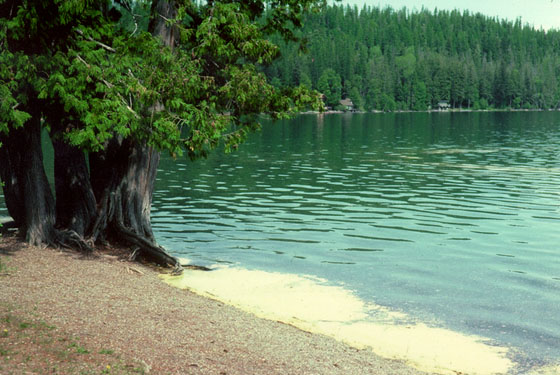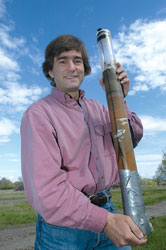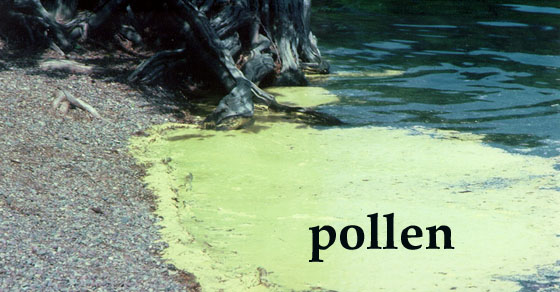|
Pollen on Lake McDonald 
Photo by Rod Benson
The birds and the bees . . .
This picture, taken in May, shows an abundance of yellow pollen on Lake McDonald in Glacier National Park. Every spring male cones on coniferous trees in the area release billions of tiny yellow pollen grains. Some land on female cones, grow a pollen tube into the female cone, and fertilize egg cells found there. Once these egg cells have been fertilized, the female cones close up and fertilized eggs develop into seeds that are eventually released when mature cones open up about 15 months after pollination.
CLICK HERE to watch a YouTube Video: "The Birds and Bees of Ponderosa Pine Trees" (2:22)
Like tree rings . . .
Eventually much of the pollen settles to the bottom of the lake where it becomes part of a layer of sediment. During the summer pieces of sand and silt, carried to the lake by streams, settle to the bottom forming a layer of sediment. Much smaller particles of clay, also transported by streams, remain suspended in the lake until the lake freezes over in the winter. Only then does the water become calm enough to allow these tiny particles to settle. If the sediments aren't stirred up by waves or burrowing animals, each year will be marked by a sandy summer layer topped by a finer-grained winter layer. CLICK HERE to see a large photo of pollen on a lake between Missoula and Great Falls.
 A piece of the puzzle . . .
A piece of the puzzle . . .
Pollen grains in these annual layers can help scientists understand past climates of the region around the lake. Scientists take core samples from the lake sediment and then analyze them in a laboratory. Based on the type of pollens contained in the sediments, they can determine which types of plants thrived in the area when specific layers were deposited. Since different plants thrive in different climates, this helps piece together a picture of what the climate was like in years gone by. Lake cores have been found with thousands of annual layers. These layers can also provide clues about the timing of volcanic eruptions, which deposit layers of ash in the lake. Scientists can even learn about the history of forest fires in the area . . . Layers containing charcoal tell about the timing of fires, and the sizes of charcoal pieces helps determine the proximity of fires to the lake.
Right: This photo, provided by the University of Montana, shows Professor Marc Hendrix with a sediment core taken from Flathead Lake. To find out more about what was learned from this coring project, click on the Hot Link below. Also, the September 2004 issue of National Geographic Magazine (pages 58-75) features an extensive article about the use of coring and other techniques to learn about past climates throughout the world. The article includes several interesting photos and graphs.
Below: A closer view of the pollen.

Term: paleoclimatology
| 








